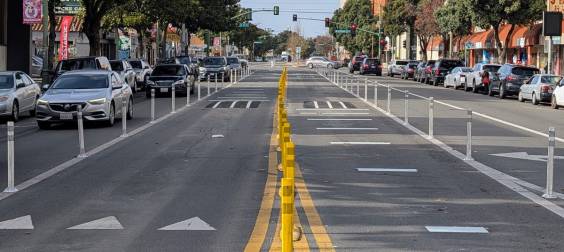Note: GJEL Accident Attorneys regularly sponsors coverage on Streetsblog San Francisco and Streetsblog California. Unless noted in the story, GJEL Accident Attorneys is not consulted for the content or editorial direction of the sponsored content.
Imagine buying one ticket that's valid on BART, Muni, Caltrain, or any of the other nearly thirty transit operators in the Bay Area, with the price based only on how far you go. Seamless Bay Area, an advocacy group focused on that goal, has released a map and mock-up proposal for an "Integrated Transit Fare Vision" that would do just that.
From the Seamless release:
The map divides the Bay Area into a series of 7-mile-wide zones, each about the size of San Francisco. Fares are easy to calculate; riders simply count the minimum number of zones required to go between two points on the map, then look up the corresponding fare in the table.
"We're not saying this is the only model that would work or that this should be the exact pricing structure," Seamless Bay Area's Ian Griffiths told Streetsblog. Rather, the idea is to use it to "... galvanize public interest and support for integration and make sure people are watching and showing up to MTC meetings and board meetings of different transit agencies and saying, 'we have to do this.'"
Of course, the idea of a zone system where riders don't have to worry about what transit systems they're on is familiar to anyone who has lived in Europe. Go to London, Zurich, or Copenhagen, for example, and, in most cases, one transfers seamlessly from the subway to light rail, to the bus, to ferries, to surface trains, all on one ticket. Often the transit is operated by different public agencies and even private companies, but riders don't have to think about that: an umbrella agency collects the fares and disburses them to the operators seamlessly. Riders never have to worry about having more than one ticket type or about getting charged again because they transferred to another operator's train or bus.
More from the Seamless web page:
Riders shouldn’t have to choose between the bus and the train because of price. With the Integrated Fare Vision, local riders could always choose the fastest route for their local fare. For example, if the fastest way of taking a local trip is to go two stops on BART, then transfer to a local bus - the price of that trip would be the same as taking the bus the whole way.
The same kind of integration would apply for monthly passes (and monthly passes would also then be available on systems that don't currently offer one, such as BART), as per this chart from the Seamless proposal:
Except in the Seamless vision, monthly passes would operate a little differently. That's another thing emulated from London, Copenhagen, and other European cities: fare caps replace daily, weekly, and monthly passes. So rather than forcing riders to try and read the future and figure out whether a monthly pass or buying single tickets is more economical, the new structure handles that for them. As explained on the Seamless page:
Instead of monthly or daily passes you have to buy before you travel, the Fare Vision Map proposes daily, weekly, and monthly fare caps available to all riders, so that anyone who reaches the cap will enjoy the rest of the transit rides they take during that time period for free.
Fare caps, experience in European cities has shown, end up increasing ridership and overall revenue because riders have one less thing to think about when deciding whether to use transit.
This hints at an important equity component of fare integration--if someone doesn't have enough money up-front to purchase a monthly pass, they might end up paying extra by buying daily tickets all month. That doesn't happen under a cap plan like Seamless is proposing. It also means low-income and other discounts will apply the same way across all systems.
“Effective transportation is a racial justice issue. Affordable and integrated fares are essential to ensuring those who most depend on public transit can get where they need to go,” said TransForm’s Policy Advocacy Manager Hayley Currier, as quoted in the Seamless proposal. “The Integrated Fare Vision provides a blueprint for a more just and integrated fare system.”
In the Seamless vision, Clipper would remain as the fare card media.
The Seamless proposal is more than another fantasy map: the organization worked with Assemblymember David Chiu on A.B. 2057, the “Bay Area Seamless Transit Act,” which would force the Bay Area’s 27 transit agencies to harmonize fares and work on creating schedules that facilitate easy transfers between systems. Chiu withdrew the bill amidst the COVID crisis last spring, but Seamless and Chiu have every intention of reintroducing it in a future legislative session, once the pandemic emergency has subsided.
That is, if legislation turns out to be the only possible route. Griffiths is also pursuing this dream by non-legislative means, via the MTC's Blue Ribbon Taskforce, which is studying fare integration right now. Griffiths expects to have an announcement next month.
"The momentum seems to be with us right now," Griffiths told Streetsblog. And the fare template they've created, he explained, is a way to illustrate how that end goal--of an integrated, seamless fare structure--would work in practice.
Be sure to check out the full Seamless "Integrated Transit Fare Vision," especially the fare calculator, to compare to the current system.
Seamless is hosting a webinar and Q&A session about the Fare Vision Map on Nov. 10th at 1 p.m. for anyone who wants to learn more.






